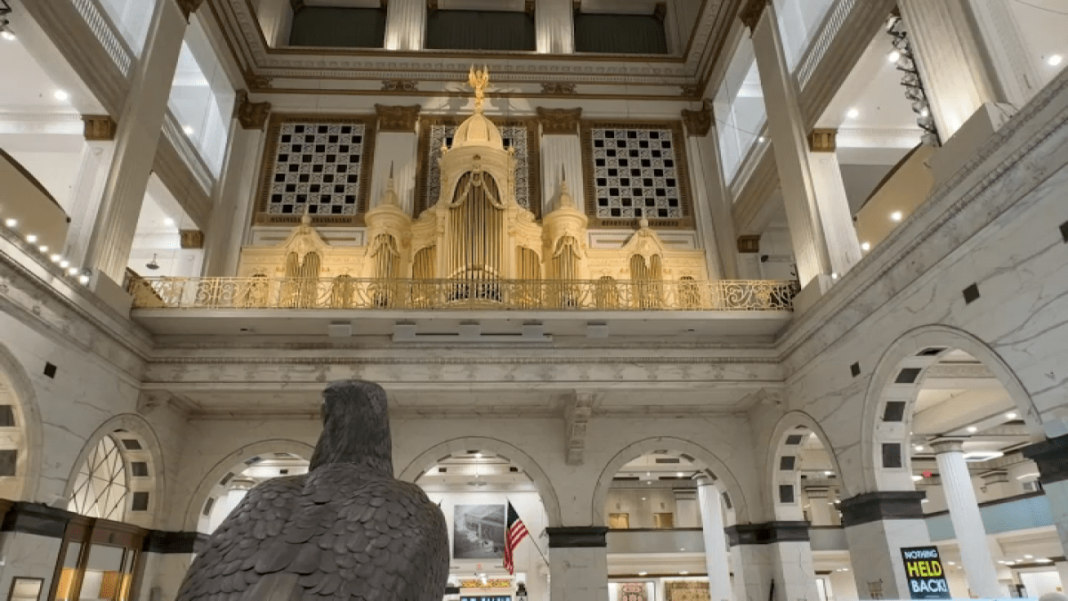## The End of an Era: Center City Philly Bids Farewell to Macy’s
For generations, the grand dame of Center City Philadelphia has stood as a beacon of retail, a destination for holiday shopping sprees and everyday essentials. But today, the doors of Macy’s will close for the final time, marking the end of an era and leaving a gaping hole in the city’s retail landscape.

Philadelphia’s Response: City Officials React to Job Losses
The impending closure of Macy’s in Center City Philadelphia has sparked concern among city officials about the potential impact on local jobs. During a Thursday afternoon press conference, Philadelphia’s Director of Commerce Alba Martinez expressed her commitment to supporting affected employees. “To the employees impacted by this decision, we are here to support you. The city’s workforce system led by Pat Clancy, also here today, is prepared to assist you with job placement,” Martinez stated. The closure is expected to result in job losses for hundreds of workers, highlighting the broader economic challenges facing the retail sector.
Voices From the Aisles: Shoppers Reflect on the Closing
Mixed Reactions: Nostalgia, Understanding, and Apprehension
The news of Macy’s closing has elicited a range of emotions from the shoppers who frequent the store. Some expressed a sense of nostalgia, recalling fond memories associated with the iconic department store. Others acknowledged the changing retail landscape, understanding the pressures facing brick-and-mortar businesses in the face of online competition. However, a palpable apprehension lingered among many, particularly those who rely on the store for employment.
“I think they haven’t recovered from COVID,” shopper Tiffany told Unionjournalism. “This is happening all over the country. A lot of businesses are closing.” Her sentiment reflects a broader concern about the economic fallout from the pandemic, which has disproportionately affected the retail sector.
Another shopper, Carlo Campbell, offered a more analytical perspective. “It’s also emblematic of the direction that society is heading with all of our online purchasing,” he stated. Campbell’s observation highlights the profound impact of e-commerce on traditional retail models, forcing businesses to adapt or face closure.
The Shifting Retail Landscape: Online Shopping’s Impact on Brick-and-Mortar Stores
The closure of Macy’s in Center City Philadelphia underscores the ongoing challenges facing brick-and-mortar retailers in a rapidly evolving consumer landscape. The meteoric rise of e-commerce has fundamentally altered shopping habits, with consumers increasingly opting for the convenience and affordability of online purchases.
According to a recent report by the U.S. Census Bureau, online retail sales have surged in recent years, accounting for a growing share of total retail sales. This trend has forced many brick-and-mortar stores to adapt, embracing omnichannel strategies that integrate online and offline shopping experiences. However, some retailers, such as Macy’s, have struggled to keep pace with these changes, ultimately leading to store closures.
A Farewell to a Familiar Landmark: What Center City Loses
The closure of Macy’s marks the end of an era for Center City Philadelphia. The iconic department store, housed in the former Philadelphia Wanamaker’s building, has been a fixture in the city’s retail scene for decades. For many Philadelphians, Macy’s was more than just a shopping destination; it was a symbol of the city’s history and character.
The store’s Christmas lights show, a beloved tradition for generations, will no longer illuminate the cityscape. The grand court, with its magnificent architecture and ornate details, will fall silent. The loss of Macy’s represents a significant blow to the vibrancy and identity of Center City.
Looking Ahead: What’s Next for the Space?
Preservation of the Organ and Grand Court: A Triumph for History
Amidst the sadness surrounding the closure, there is a glimmer of hope for the preservation of some of Macy’s most treasured assets: the Wanamaker Organ and the iconic grand court. The Philadelphia Historical Commission has stepped in to protect these historical landmarks, ensuring their continued presence in Center City.
“We are committed to preserving the architectural and cultural heritage of Philadelphia,” said a spokesperson for the Philadelphia Historical Commission. “The Wanamaker Organ and the grand court are irreplaceable treasures that hold significant historical and cultural value for our city.”
Potential Redevelopment: New Opportunities for the Center City Location
The closure of Macy’s presents a unique opportunity for redevelopment in a prime Center City location. Developers are already expressing interest in the property, envisioning a range of possibilities, from mixed-use projects to luxury residential spaces. The sheer size and prominence of the building make it an attractive target for investors seeking to capitalize on the city’s vibrant commercial and residential scene.
The Future of Retail in Philadelphia: Adapting to Change
The closure of Macy’s serves as a stark reminder of the challenges facing brick-and-mortar retailers in the digital age. However, it also highlights the resilience and adaptability of Philadelphia’s retail landscape. The city has a rich history of innovation and entrepreneurship, with local businesses constantly finding new ways to thrive in a changing market.
The future of retail in Philadelphia will likely involve a continued shift towards omnichannel strategies, with businesses seamlessly integrating online and offline shopping experiences. Embracing technology, fostering customer loyalty, and offering unique and personalized experiences will be key to success in the years to come.
Conclusion
The closing of Macy’s in Center City Philadelphia marks more than just the loss of a retail giant; it’s a stark reminder of the evolving landscape of urban commerce. The article detailed the store’s long history, its impact on the community, and the factors contributing to its decline, including changing consumer habits, online shopping, and rising operating costs. While the city mourns the loss of a familiar landmark, the closure also presents an opportunity for reflection and reinvention. What will fill the void left by Macy’s? Will it be another retail tenant, a mixed-use development, or something entirely different? The answer will shape the future of Center City and offer valuable insights into the challenges and opportunities facing urban retail in the digital age. One thing is certain: the story of Macy’s departure is far from over. It’s a narrative that will continue to unfold, impacting the city’s economy, its residents, and its identity for years to come. The question remains, will Philadelphia rise to the occasion and write a new chapter for this iconic location, one that reflects the changing needs and desires of its people?

